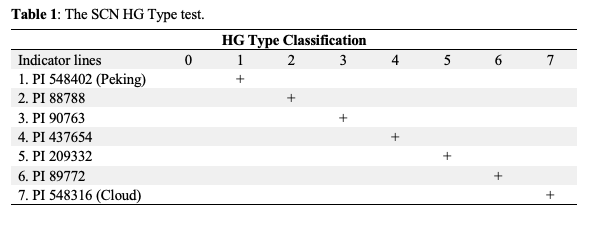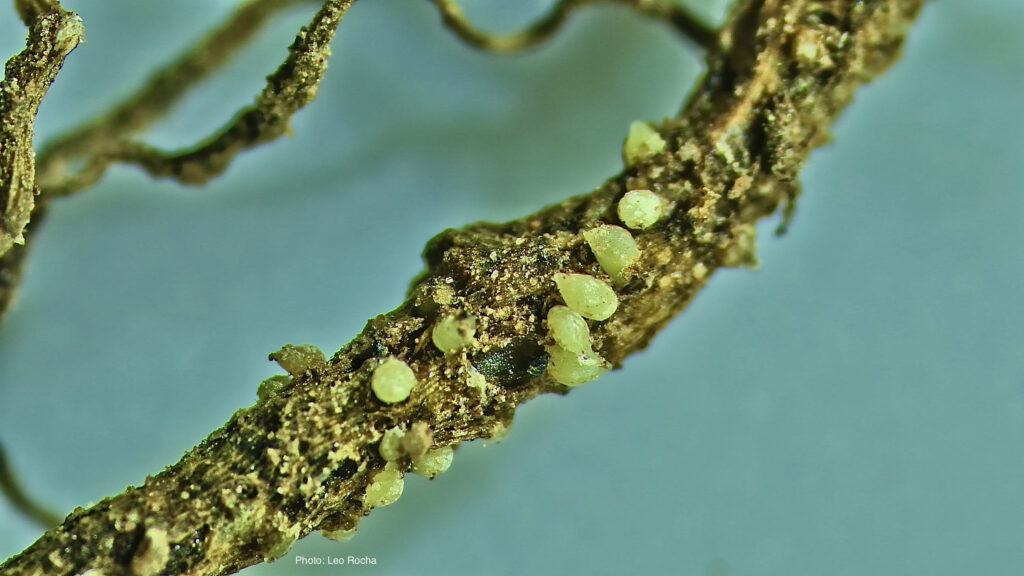The foundations of a successful Soybean Cyst Nematode (SCN) management program are based on SCN testing, crop rotation, and the use of resistant varieties. You probably heard or read somewhere about PI 88788 and the importance of rotating sources of resistance, but did you know that HG type testing can determine the resistance levels of the SCN populations in your farm?
An HG type test measures the ability of SCN field populations to reproduce on a set of soybean varieties or breeding lines. These indicator lines are Peking (PI 548402), PI 88788, PI 90763, PI 437654, PI 209332, PI 89772, and Cloud (PI 548316). PI stands for “Plant Introduction” and is a universal way to catalog plant genotypes. The “HG” represents the first letters of SCN’s scientific name (Heterodera glycines). The HG type test was introduced 20 years ago and replaced the former race system.
The table below summarizes how the HG type test is interpreted. A “+” indicates that an SCN population could reproduce on that indicator line. A HG type 0 population does not reproduce on any indicator lines, while HG type 1 reproduces only on PI 548401 (Peking), …, and HG Type 7 reproduces only on PI 548316 (Cloud). Most SCN populations in this region can reproduce on more than one indicator line, and HG type numbers will stack up. For example, an HG type 5.7 denotes a population that can reproduce on both PI 209332 (indicator line 5) and PI 548316 (Cloud) (indicator line 7).
A variety with high susceptibility to SCN is also included when these tests are conducted. In the end, the SCN numbers in all the indicator lines are compared to this highly susceptible line. When the SCN counts in an indicator line are at least 10% of those in the susceptible one, we assume these populations are breaking resistance. This information is relevant because even though a population has a 2 in an HG type (e.g., 2.5.7), that does not mean PI 88788 is completely ineffective in that scenario. This source of resistance can still help to manage SCN populations to a certain level. Still, these results remind us that rotating sources of resistance is critical to maintaining this genetics working in the field.

Table 1: The SCN HG Type test.
Based on a recent study by the University of Illinois, our state’s most common HG type is 2.5.7. Returning to the table, this indicates that these populations can reproduce on PI 88788, PI 209332, and PI 548316. In fact, 100% of the populations in that study could reproduce on PI 88788, the primary source of resistance to SCN, highlighting that we are losing an essential management tool. Only a small fraction (<5%) of the SCN populations in the study reproduced on PI 548402 (Peking), emphasizing the potential of this source of resistance to managing SCN in Illinois. Even if you do not know the HG type of your populations, look at your seed catalog and talk to your seed provider to explore varieties with Peking-derived resistance for the upcoming growing seasons.

Figure 1: An elevated number of soybean cyst nematode females (cysts) developing on a variety with PI 88788 resistance. Samples were collected on 06/27/2023 in White County, Illinois.
On your next SCN sampling, please consider conducting an HG type test in some samples to identify the populations present on your farm. I strongly recommend you to read the publication linked below, “Understanding Soybean Cyst Nematode HG types and Races” by Greg Tylka, if you want to know more!
References
Kleczewski, N., Colgrove, A. L., Harbach, C. J., Bowman, N. D., & Plewa, D. (2022). A survey of soybean cyst nematode population densities and phenotypes in Illinois: 2018 and 2020. Plant Health Progress. https://apsjournals.apsnet.org/doi/pdf/10.1094/PHP-09-22-0092-S
Tylka, G. L. (2016). Understanding soybean cyst nematode HG types and races. Plant Health Progress, 17(2), 149-151. Link: https://apsjournals.apsnet.org/doi/pdf/10.1094/PHP-PS-16-0615
The SCN Coalition. (2021). HG Types and SCN Races Explained. Link: https://www.thescncoalition.com/wp-content/uploads/2021/12/Converting_SCN_Races_to_HG_Types_Jan_2019-Resource.pdf




 and then
and then